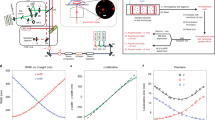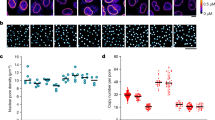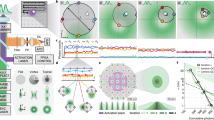Abstract
Export of messenger RNA occurs via nuclear pores, which are large nanomachines with diameters of roughly 120 nm that are the only link between the nucleus and cytoplasm1. Hence, mRNA export occurs over distances smaller than the optical resolution of conventional light microscopes. There is extensive knowledge on the physical structure and composition of the nuclear pore complex2,3,4,5,6,7, but transport selectivity and the dynamics of mRNA export at nuclear pores remain unknown8. Here we developed a super-registration approach using fluorescence microscopy that can overcome the current limitations of co-localization by means of measuring intermolecular distances of chromatically different fluorescent molecules with nanometre precision. With this method we achieve 20-ms time-precision and at least 26-nm spatial precision, enabling the capture of highly transient interactions in living cells. Using this approach we were able to spatially resolve the kinetics of mRNA transport in mammalian cells and present a three-step model consisting of docking (80 ms), transport (5–20 ms) and release (80 ms), totalling 180 ± 10 ms. Notably, the translocation through the channel was not the rate-limiting step, mRNAs can move bi-directionally in the pore complex and not all pores are equally active.
This is a preview of subscription content, access via your institution
Access options
Subscribe to this journal
Receive 51 print issues and online access
$199.00 per year
only $3.90 per issue
Buy this article
- Purchase on Springer Link
- Instant access to full article PDF
Prices may be subject to local taxes which are calculated during checkout




Similar content being viewed by others
References
Stoffler, D. et al. Cryo-electron tomography provides novel insights into nuclear pore architecture: Implications for nucleocytoplasmic transport. J. Mol. Biol. 328, 119–130 (2003)
Kiseleva, E., Goldberg, M. W., Allen, T. D. & Akey, C. W. Active nuclear pore complexes in Chironomus: visualization of transporter configurations related to mRNP export. J. Cell Sci. 111, 223–236 (1998)
Rout, M. P. et al. The yeast nuclear pore complex: Composition, architecture, and transport mechanism. J. Cell Biol. 148, 635–652 (2000)
Beck, M. et al. Nuclear pore complex structure and dynamics revealed by cryoelectron tomography. Science 306, 1387–1390 (2004)
Frey, S. & Gorlich, D. A saturated FG-repeat hydrogel can reproduce the permeability properties of nuclear pore complexes. Cell 130, 512–523 (2007)
Alber, F. et al. The molecular architecture of the nuclear pore complex. Nature 450, 695–701 (2007)
Lim, R. Y. et al. Nanomechanical basis of selective gating by the nuclear pore complex. Science 318, 640–643 (2007)
Mor, A. et al. Dynamics of single mRNP nucleocytoplasmic transport and export through the nuclear pore in living cells. Nature Cell Biol. 12, 543–552 (2010)
Stockley, P. G. et al. Probing sequence-specific RNA recognition by the bacteriophage MS2 coat protein. Nucleic Acids Res. 23, 2512–2518 (1995)
Fusco, D. et al. Single mRNA molecules demonstrate probabilistic movement in living mammalian cells. Curr. Biol. 13, 161–167 (2003)
Hallberg, E., Wozniak, R. W. & Blobel, G. An integral membrane protein of the pore membrane domain of the nuclear envelope contains a nucleoporin-like region. J. Cell Biol. 122, 513–521 (1993)
Cronshaw, J. A., Krutchinsky, A. N., Zhang, W. Z., Chait, B. T. & Matunis, M. J. Proteomic analysis of the mammalian nuclear pore complex. J. Cell Biol. 158, 915–927 (2002)
Yildiz, A. et al. Myosin V walks hand-over-hand: single fluorophore imaging with 1.5-nm localization. Science 300, 2061–2065 (2003)
Nachury, M. V. & Weis, K. The direction of transport through the nuclear pore can be inverted. Proc. Natl Acad. Sci. USA 96, 9622–9627 (1999)
Kopito, R. B. & Elbaum, M. Reversibility in nucleocytoplasmic transport. Proc. Natl Acad. Sci. USA 104, 12743–12748 (2007)
Bachi, A. et al. The C-terminal domain of TAP interacts with the nuclear pore complex and promotes export of specific CTE-bearing RNA substrates. RNA 6, 136–158 (2000)
Chakraborty, P., Satterly, N. & Fontoura, B. M. Nuclear export assays for poly(A) RNAs. Methods 39, 363–369 (2006)
Carmody, S. R. & Wente, S. R. mRNA nuclear export at a glance. J. Cell Sci. 122, 1933–1937 (2009)
Franke, W. W. & Scheer, U. The ultrastructure of the nuclear envelope of amphibian oocytes: a reinvestigation. II. The immature oocyte and dynamic aspects. J. Ultrastruct. Res. 30, 317–327 (1970)
Franke, W. W. & Scheer, U. The ultrastructure of the nuclear envelope of amphibian oocytes: a reinvestigation. I. The mature oocyte. J. Ultrastruct. Res. 30, 288–316 (1970)
Bastos, R., Pante, N. & Burke, B. Nuclear pore complex proteins. Int. Rev. Cytol. 162B, 257–302 (1995)
Cordes, V. C., Reidenbach, S., Rackwitz, H. R. & Franke, W. W. Identification of protein p270/Tpr as a constitutive component of the nuclear pore complex-attached intranuclear filaments. J. Cell Biol. 136, 515–529 (1997)
Ribbeck, K. & Gorlich, D. Kinetic analysis of translocation through nuclear pore complexes. EMBO J. 20, 1320–1330 (2001)
Macara, I. G. Transport into and out of the nucleus. Microbiol. Mol. Biol. Rev. 65, 570–594 (2001)
Peters, R. Translocation through the nuclear pore complex: selectivity and speed by reduction-of-dimensionality. Traffic 6, 421–427 (2005)
Lamond, A. I. & Spector, D. L. Nuclear speckles: a model for nuclear organelles. Nature Rev. Mol. Cell Biol. 4, 605–612 (2003)
Kubitscheck, U. et al. Nuclear transport of single molecules: dwell times at the nuclear pore complex. J. Cell Biol. 168, 233–243 (2005)
Clemen, A. E. et al. Force-dependent stepping kinetics of myosin-V. Biophys. J. 88, 4402–4410 (2005)
Dange, T., Grunwald, D., Grunwald, A., Peters, R. & Kubitscheck, U. Autonomy and robustness of translocation through the nuclear pore complex: a single-molecule study. J. Cell Biol. 183, 77–86 (2008)
Sun, C., Yang, W., Tu, L. C. & Musser, S. M. Single-molecule measurements of importin α/cargo complex dissociation at the nuclear pore. Proc. Natl Acad. Sci. USA 105, 8613–8618 (2008)
Thompson, R. E., Larson, D. R. & Webb, W. W. Precise nanometer localization analysis for individual fluorescent probes. Biophys. J. 82, 2775–2783 (2002)
Kubitscheck, U. et al. Nuclear transport of single molecules: dwell times at the nuclear pore complex. J. Cell Biol. 168, 233–243 (2005)
Acknowledgements
We thank T. Dange, K. Czaplinski, T. Lionnet and X. Meng for help with cell lines and cloning; A. Gennerich, H. Y. Park and D. Entenberg for help on data analysis and programming; S. M. Shenoy for development of alignment software for detector pre-registration and his additional support; D. Larson, I. Lepper and U. Kubitscheck for providing fitting routines; and A. Wells for FISH and TIRF data, proof reading and discussion. Lentiviral vector was a gift from G. Mostoslavsky and R. C. Mulligan. Supported by DFG 3388/1 to D.G. Supported by NIH EB2060 and GM86217 to R.H.S. The authors express their appreciation to E. Gruss Lipper for her gift founding the Gruss Lipper Biophotonics Center that provided the equipment used in this research.
Author information
Authors and Affiliations
Contributions
D.G. designed and performed experiments, established cell lines, performed data analysis and built microscopy equipment in consultation with R.H.S. D.G. and R.H.S. discussed data and wrote the manuscript.
Corresponding author
Ethics declarations
Competing interests
The authors declare no competing financial interests.
Supplementary information
Supplementary Information
This file contains Supplementary Results and Discussion, Supplementary References, Supplementary Tables 1-3 and Supplementary Figures 1-8 with legends. (PDF 746 kb)
Supplementary Movie 1
This movie shows β-actin mRNA scanning multiple pores - see Supplementary Information file for full legend. (MOV 66 kb)
Supplementary Movie 2
This movie shows the full length data set for a slow export event displayed in Fig. 1. panel K - see Supplementary Information file for full legend. (MOV 208 kb)
Supplementary Movie 3
This movie shows the fast export event from Fig. 1. panel M-P - see Supplementary Information file for full legend. (MOV 12 kb)
Supplementary Movie 4a
This movie shows mRNAs moving freely in the nucleoplasm and finally approaching nuclear pores at a low frequency. Several 'scanning' events can be visually identified - see Supplementary Information file for full legend. (MOV 2093 kb)
Supplementary Movie 4b
This movie shows mRNAs moving freely in the nucleoplasm and finally approaching nuclear pores at a low frequency. Several 'scanning' events can be visually identified displayed in real time at 50Hz - see Supplementary Information file for full legend. (MOV 2093 kb)
Supplementary Movie 5
This movie shows Animation of a 3D stack of POM121-tdTomato in the nuclear envelope - see Supplementary Information file for full legend. (MOV 3179 kb)
Supplementary Movie 6
This movie shows detection of mRNA without an NLS Signal on the MCP Label - see Supplementary Information file for full legend. (MOV 1149 kb)
Rights and permissions
About this article
Cite this article
Grünwald, D., Singer, R. In vivo imaging of labelled endogenous β-actin mRNA during nucleocytoplasmic transport. Nature 467, 604–607 (2010). https://doi.org/10.1038/nature09438
Received:
Accepted:
Published:
Issue Date:
DOI: https://doi.org/10.1038/nature09438
This article is cited by
-
CRISPR-dCas13-tracing reveals transcriptional memory and limited mRNA export in developing zebrafish embryos
Genome Biology (2023)
-
RBP–RNA interactions in the control of autoimmunity and autoinflammation
Cell Research (2023)
-
Avidity-based bright and photostable light-up aptamers for single-molecule mRNA imaging
Nature Chemical Biology (2023)
-
Nuclear export of the pre-60S ribosomal subunit through single nuclear pores observed in real time
Nature Communications (2021)
-
High-speed super-resolution imaging of rotationally symmetric structures using SPEED microscopy and 2D-to-3D transformation
Nature Protocols (2021)
Comments
By submitting a comment you agree to abide by our Terms and Community Guidelines. If you find something abusive or that does not comply with our terms or guidelines please flag it as inappropriate.



